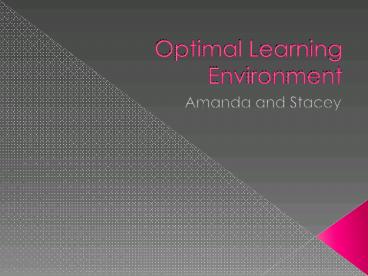Optimal Learning Environment PowerPoint PPT Presentation
1 / 23
Title: Optimal Learning Environment
1
Optimal Learning Environment
- Amanda and Stacey
2
What is OLE?
- It serves as a scaffold for educators helping
them to optimize teaching and assessment
practices for their students from diverse
linguistic and cultural backgrounds. - The goal of OLE is to create lessons and
classrooms that promote optimal learning
environments for ELL students
3
Development of OLE
- Problem incompatible lesson formats
- Originally the study looked at Latino children
who had been labeled LD - They organized lessons after reviewing what
worked in Bilingual classrooms and special
education classrooms and created Holistic
Constructivism
4
Holistic-Constructivism
5
Student Choice
- Teachers plan for students choice provide
information for students to make well-informed
decisions - Students Choose freely from information and
opportunities provided by the teacher - Classroom There is a lot of published writing,
interactive journals, portfolio pieces that
reflect choice of topic, students have chosen who
they want to work with and there is choice of
books for D.E.A.R.
6
Student Centered
- Teacher Listen to student ideas
- Students inform teachers about who they are
they employ prior knowledge and inform the
teacher about what they want to find out - Classroom There is student centered work and
students life experiences are honoured
7
Whole-Part-Whole Approach
- Teachers Initiate and center learning with the
whole text - Students Write, read and create meaning with the
whole story, poem or project in mind before
engaging in understanding how the pieces make up
the whole. - Classroom Begin with whole text but may work on
different aspects of language.
8
Active Student Participation
- Teachers Organize opportunities for students to
collaborate with each other to construct
knowledge. - Students Actively listen, speak, write and read
during lessons. - Classroom Think-Pair Share, Four Corners, Heads
Together.
9
Focus on Ideas Before Mechanics
- Teachers Know that learners construct meaning
prior to learning language forms - Students Believe what they say had meaning and
their ideas will be listened to. - Classroom Includes many written pieces
10
Authentic Purpose
- Teachers Ask students to write as real authors
with an intended audience and function and to
read for information, enjoyment and reflection - Students Use literacy skills for a purpose
- Classroom lists, brainstorm webs, students
books, context for purposeful reading, writing
and speaking across the curriculum
11
Immersion in Language and Print
- Teachers provide a wide variety of functional
print, meaningful oral language - Students read print from walls and a wide
variety of books, talk and listen to others,
construct knowledge from language rich and print
saturated environments - Classroom filled with a wide range of print
12
Teacher and Peer Demonstrations
- Teachers demonstrate reading, writing and
speaking - Students demonstrate their competency across the
curriculum - Classroom provide space for students to
demonstrate their learning
13
Approximation
- Teachers accept successive approximations
- Students take risks and become authors, readers
and experts and understand that their first
attempt doesnt have to be perfect - Classroom displays monthly writing samples,
social organization that allows for approximate
language and literacy by interacting with peers
who are more linguistically competent
14
Immediate Response
- Teachers respond to student work right away
- Students respond to peers
- Classroom allow for small groups and one on one
interaction
15
Classroom as Learning Communities
- Teachers act as members of the classroom
community, creates context in which students can
share - Students participate as members of a community
- Classroom should reflect the community of
learners
16
High Expectations
- Teachers have high expectations for students to
become literate - Students expect that their learning environments
provide them with what they need to make sense of
the world, expect others to actively participate
in the community - Classroom demonstrates student learning
17
- Researchers believe that at risk students,
particularly those with limited English
proficiency, are forgiven for mistakes based on
language barriers or their progress is not
properly assessed - It is imperative to provide at risk learners with
cognitively challenging instruction requiring
them to think and analyze not only rote,
repetitive detail level drills - It requires careful levelling of tasks so that
students are working within their zones of
proximal development
18
Instructional Strategies for OLEs
- Interactive Journals
- ABC wall chart or class book
- Shared Reading with predictable texts
- Pattern Writing with predictable texts
- D.E.A.R with reading log
- Literature study using graphic organizers
- Creating text for wordless books
- Writers Workshop
19
Predictable Texts
- Brown Bear, Brown Bear, What Do You See?
- Bill Martin Jr. and Eric Carle
- Activity
- ________, ________ what do you see? I see a
_________ looking at me. - Each student fills in the sentence with new
animals, the teacher can then have the students
illustrate the sentence and create a class book.
20
(No Transcript)
21
Authentic Assessment
- Idea that educators should assess students
development while authentically engaged in
focused activities
22
- Any Questions?????
23
References
- Ruiz, Nadeen T. (1989). An Optimal Learning
Environment for Rosemary. Exceptional Children
57, no. 2, 130-144. - Ruiz, Nadeen T., Garcia, Erminda, Figueroa,
Richard A. (1996). The OLE Curriculum Guide. CA
California Department of Education Specialized
Programs Branch.

